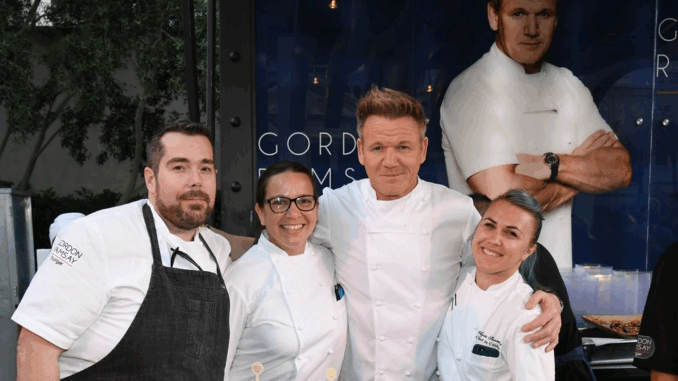
It was supposed to be a routine filming day—another intense kitchen challenge, another dramatic turnaround for television. But if you talk to anyone who was in that San Francisco restaurant the night Gordon Ramsay stopped by, they’ll tell you this wasn’t like anything they’d seen before.
The crew had been buzzing since morning. Hell’s Kitchen had chosen their restaurant as a reward spot, and by mid-afternoon, the cameras were everywhere. The dining room had been transformed into a stage, the kitchen lit like a movie set, and the air was thick with the smell of seared meat and nervous anticipation.
At first, Ramsay played his role exactly as expected. He worked the room, filmed with the winning team, and stayed close to the production crew. People whispered when he passed, stealing glances like they were spotting a celebrity in the wild. But the real story began after the cameras stopped rolling.
A Quiet Return to the Kitchen
Most celebrities would have left. The shoot was over, the lights were being packed away, and the bar had become a casual hangout spot for Ramsay and a few crew members. But at the peak of dinner service—when the real chaos of a restaurant begins—he slipped away from the bar and walked straight into the open kitchen.
And then… he didn’t take over.
He didn’t shout. He didn’t demand to see the menu or critique the plating. He simply stood back, hands behind his back, watching the brigade work. For the chefs, it was surreal. The man known for his volcanic temper was standing there in total silence, just observing the rhythm of the kitchen as if he were studying a painting.
The Conversations No One Expected
When the last few tickets were hanging on the line, Ramsay began to move closer—one cook at a time. He asked where they were from, how long they’d been cooking, and what they wanted to do next. There was no judgment in his voice, only curiosity.
Even the waitstaff got their moment. One server later described shaking his hand and feeling like he was “really there” in the conversation—not distracted, not rushing, just present.
By the time the final plate left the kitchen, Ramsay had made the rounds to everyone. He posed for pictures, cracked jokes at the head chef’s expense, and left the entire staff wondering whether they’d just seen the real Gordon Ramsay—not the one made for TV.
The FOX Question
Later, in the quiet after service, one waiter made a joke that stuck:
“There must be someone at FOX whose job it is to poke Ramsay with a pin if he doesn’t curse every two minutes.”
The more they thought about it, the more it made sense. On television, Ramsay’s fury is the hook—people tune in to see him erupt. But that night proved there’s another side to him, one the cameras rarely show.

Why This Story Still Matters
For fans, the story became something of a legend. It’s passed around online like a secret: proof that behind the fiery persona is a man who can be disarmingly kind, deeply respectful of the craft, and genuinely curious about the people who work in his industry.
But it also raises a bigger question—how much of Gordon Ramsay is performance, and how much is the real man?
Some say his on-screen outbursts are an act, carefully designed to create ratings. Others argue they’re just a heightened version of his natural intensity. The truth is probably somewhere in between.
What’s certain is that the people in that San Francisco kitchen that night saw something most viewers never will. And once you’ve seen it, the shouting and swearing on television start to look a little different.
